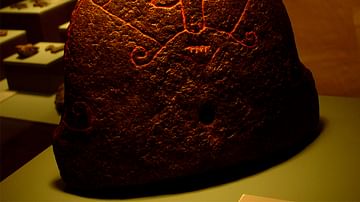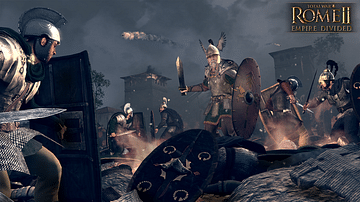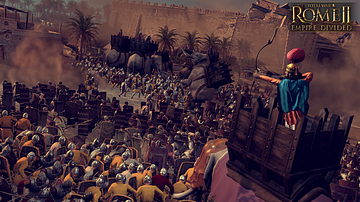Search Images
Browse Content (p. 1183)

Image
Loki's Punishment
Painting by Christoffer Wilhelm Eckersberg from 1810 CE depicting a scene from Norse mythology in which Loki is punished by the gods for his hand in the death of Baldr. A serpent is suspended above his head, dripping poison onto him, but...

Image
The Snaptun Stone
The Viking Age Snaptun stone was carved around 1000 CE and shows a face with stitched-up lips, which reminds of a story preserved in the Prose Edda where the Norse god's Loki’s lips are sewn up. As such, it is usually thought to be one of...

Image
Colossal Statue of Shapur I
Colossal Statue of Shapur I (240-270 CE), located in the Shapur Cave in modern-day Iran.

Image
Cniva in Battle
An artist's impression of Cniva, the king of the Goths (c. 250 - c. 270 CE), in battle as depicted in the PC game Rome II: Total War - Empire Divided.

Image
Illustration of Colossal Statue of Shapur I
An engraving of the colossal statue of Shapur I, who ruled the Sasanian empire from 240 to 270 CE, which stands in the Shapur cave, Bhishapur. (From "The Seven Great Monarchies Of The Ancient Eastern World", Vol. 3, 1876 CE).

Image
Hormizd I in Battle
An artist's impression of Hormizd, the Sassanid ruler (r. 270- c. 273 CE), in battle as depicted in the PC game Rome II: Total War - Empire Divided.

Image
Coin of Shapur I
A silver coin of Shapur I who ruled the Sasanian empire from 240 to 270 CE. (Reza Abbasi Museum, Tehran, Iran)

Image
Battle Frieze from Ancient Black Sea Region
This is a fragment of a frieze depicting a battle scene. It might perhaps depict a battle scene between ancient Greek warriors and the legendary Amazons. It comes from present-day Yubileynoye, which is located on Russia's Taman peninsula...

Image
Roman Mummy Masks
These Roman mummy masks come from ancient Egypt. They date from the 1st-2nd century CE, and they painted and made from plaster. (Pushkin Museum, Moscow)

Image
Necklace from Ancient Armenia
This necklace was unearthed in what is now present-day Armenia and dates from the 15th-13th century BCE. It contains gold and other sardonyx beads. (Metsamor Historical-Archaeological Museum-Reserve, Taronik, Armenia)